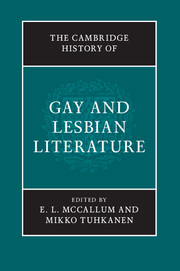17 results
Chapter 18 - Baldwin and Psychoanalysis
- from Part 2 - Social and Cultural Contexts
-
-
- Book:
- James Baldwin in Context
- Published online:
- 12 July 2019
- Print publication:
- 01 August 2019, pp 187-198
-
- Chapter
- Export citation
Introduction
-
-
- Book:
- The Cambridge History of Gay and Lesbian Literature
- Published online:
- 18 December 2014
- Print publication:
- 17 November 2014, pp 1-12
-
- Chapter
- Export citation
Part III - Enlightenment Cultures
-
- Book:
- The Cambridge History of Gay and Lesbian Literature
- Published online:
- 18 December 2014
- Print publication:
- 17 November 2014, pp 239-322
-
- Chapter
- Export citation
Copyright page
-
- Book:
- The Cambridge History of Gay and Lesbian Literature
- Published online:
- 18 December 2014
- Print publication:
- 17 November 2014, pp iv-iv
-
- Chapter
- Export citation
Part VI - Genres of the Present
-
- Book:
- The Cambridge History of Gay and Lesbian Literature
- Published online:
- 18 December 2014
- Print publication:
- 17 November 2014, pp 587-732
-
- Chapter
- Export citation
Part I - Reading Ancient and Classical Cultures
-
- Book:
- The Cambridge History of Gay and Lesbian Literature
- Published online:
- 18 December 2014
- Print publication:
- 17 November 2014, pp 13-142
-
- Chapter
- Export citation
Part V - Geographies of Same-Sex Desire in the Modern World
-
- Book:
- The Cambridge History of Gay and Lesbian Literature
- Published online:
- 18 December 2014
- Print publication:
- 17 November 2014, pp 419-586
-
- Chapter
- Export citation

The Cambridge History of Gay and Lesbian Literature
-
- Published online:
- 18 December 2014
- Print publication:
- 17 November 2014
The Cambridge History of Gay and Lesbian Literature - Half title page
-
- Book:
- The Cambridge History of Gay and Lesbian Literature
- Published online:
- 18 December 2014
- Print publication:
- 17 November 2014, pp i-ii
-
- Chapter
- Export citation
Part II - Renaissance and Early Modern
-
- Book:
- The Cambridge History of Gay and Lesbian Literature
- Published online:
- 18 December 2014
- Print publication:
- 17 November 2014, pp 143-238
-
- Chapter
- Export citation
Acknowledgments
-
- Book:
- The Cambridge History of Gay and Lesbian Literature
- Published online:
- 18 December 2014
- Print publication:
- 17 November 2014, pp xiii-xiv
-
- Chapter
- Export citation
Index
-
- Book:
- The Cambridge History of Gay and Lesbian Literature
- Published online:
- 18 December 2014
- Print publication:
- 17 November 2014, pp 733-747
-
- Chapter
- Export citation
The Cambridge History of Gay and Lesbian Literature - Title page
-
-
- Book:
- The Cambridge History of Gay and Lesbian Literature
- Published online:
- 18 December 2014
- Print publication:
- 17 November 2014, pp iii-iii
-
- Chapter
- Export citation
Contents
-
- Book:
- The Cambridge History of Gay and Lesbian Literature
- Published online:
- 18 December 2014
- Print publication:
- 17 November 2014, pp v-x
-
- Chapter
- Export citation
Part IV - Queer Modernisms
-
- Book:
- The Cambridge History of Gay and Lesbian Literature
- Published online:
- 18 December 2014
- Print publication:
- 17 November 2014, pp 323-418
-
- Chapter
- Export citation
Contributors
-
-
- Book:
- The Cambridge History of Gay and Lesbian Literature
- Published online:
- 18 December 2014
- Print publication:
- 17 November 2014, pp xi-xii
-
- Chapter
- Export citation
6 - Queer Hybridity
-
-
- Book:
- Deleuze and Queer Theory
- Published by:
- Edinburgh University Press
- Published online:
- 12 September 2012
- Print publication:
- 30 January 2009, pp 92-114
-
- Chapter
- Export citation

